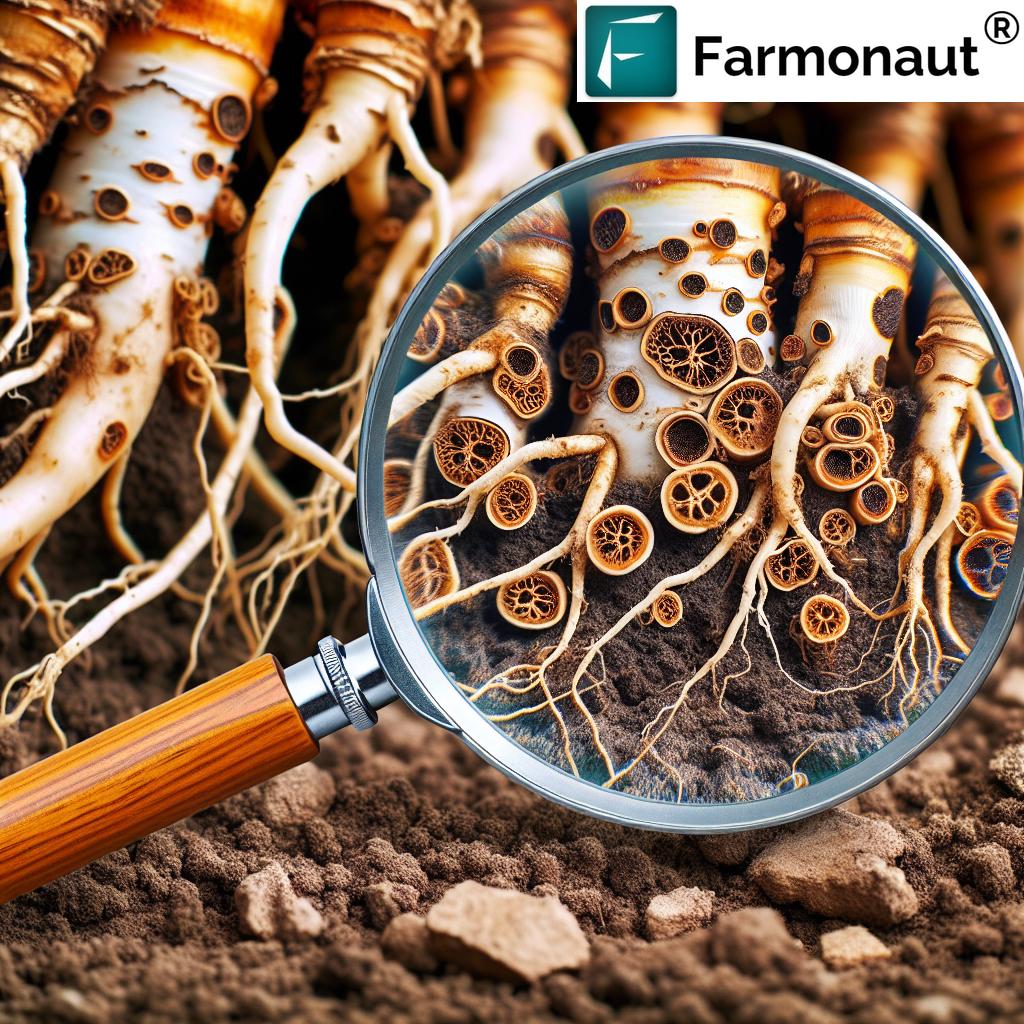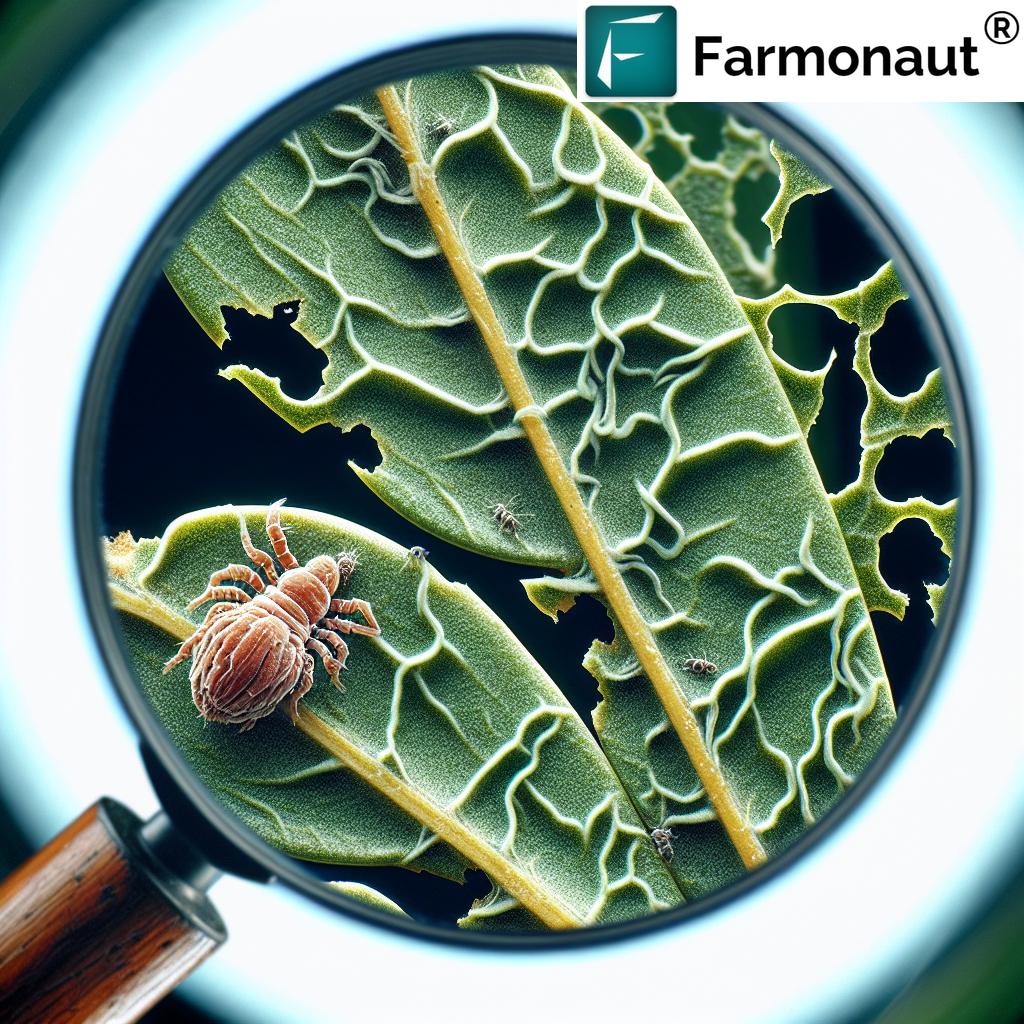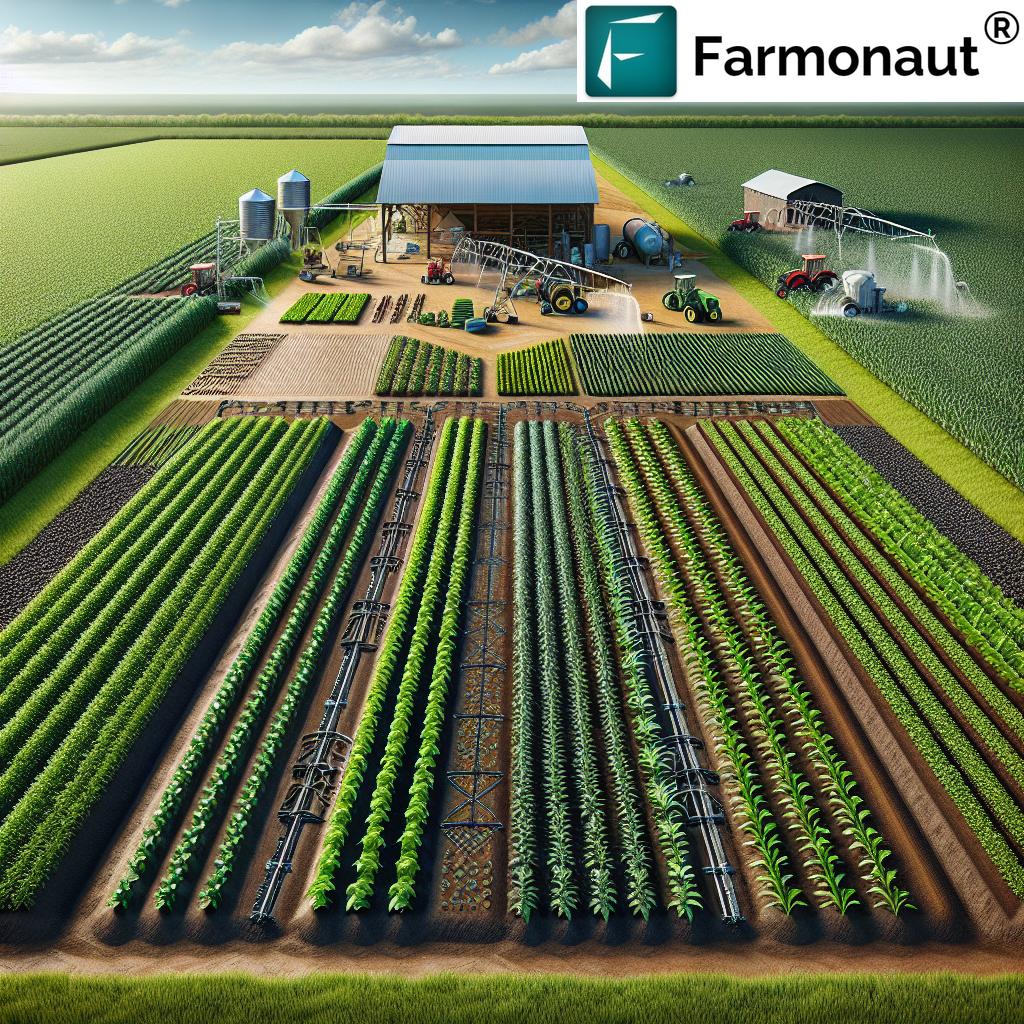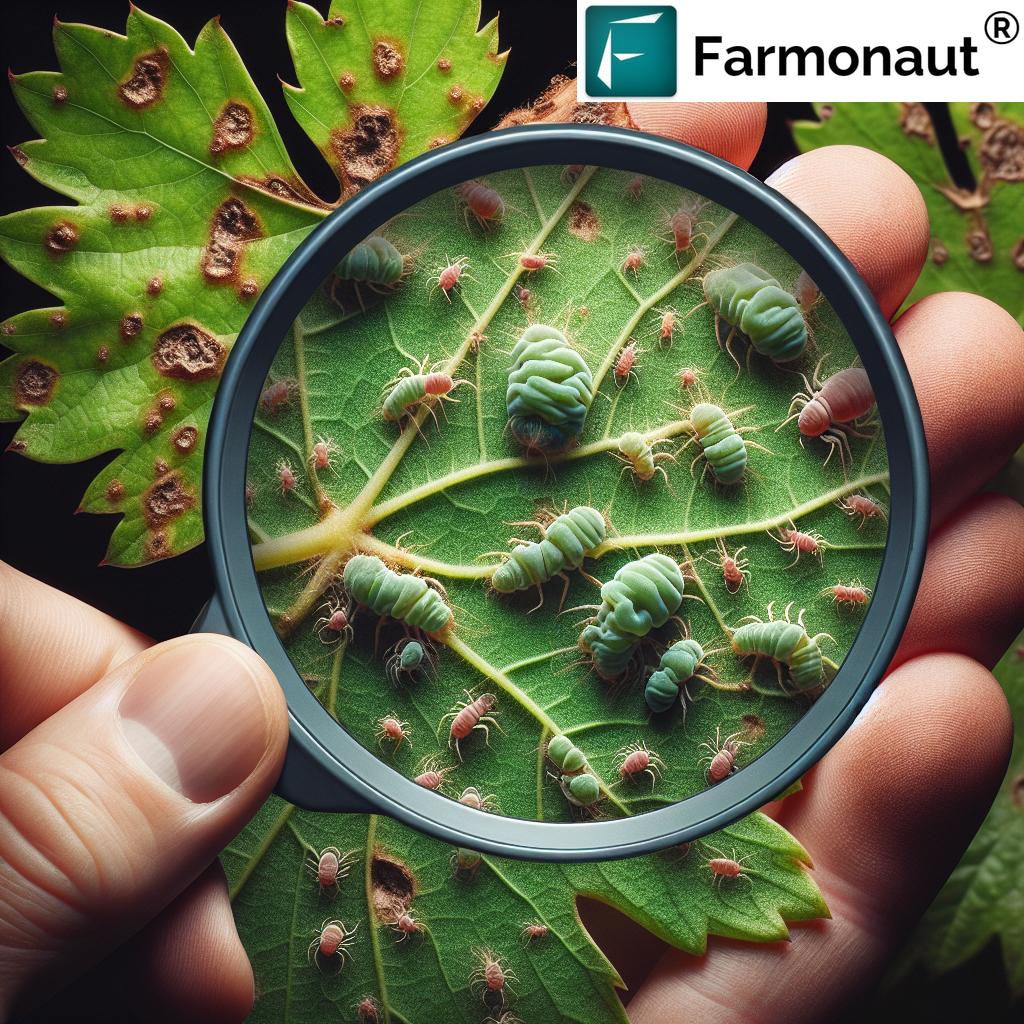Combating Rhizoctonia: A Comprehensive Guide to Protecting Your Crops

As agricultural technology experts at Farmonaut, we understand the challenges farmers face when dealing with crop diseases. One particularly troublesome pathogen that plagues many crops is Rhizoctonia. This fungus can cause significant damage to a wide range of plants, leading to reduced yields and economic losses. In this comprehensive guide, we’ll explore the nature of Rhizoctonia, its impact on various crops, and the most effective control measures to protect your fields.
Understanding Rhizoctonia: The Silent Threat to Your Crops
Rhizoctonia is a genus of fungi that includes several species known to cause various plant diseases. The most notorious among them is Rhizoctonia solani, which is responsible for a range of plant health issues, including:
- Root rot
- Damping-off of seedlings
- Stem cankers
- Foliar blights
This fungus thrives in soil and can affect a diverse array of crops, including:
- Rice
- Beet
- Cucumber
- Strawberry
- Potatoes
- Corn
- Soybeans
Additionally, Rhizoctonia can cause significant damage to turf and ornamental grass species, making it a concern for both agricultural and landscaping industries.
The Life Cycle of Rhizoctonia: Understanding the Enemy
To effectively combat Rhizoctonia, it’s crucial to understand its life cycle and how it spreads through your fields. The fungus typically follows these stages:
- Survival: Rhizoctonia can survive in soil as sclerotia (compact masses of hardened fungal mycelium) or as mycelium in plant debris.
- Germination: When conditions are favorable (warm and moist), the fungus begins to grow and spread through the soil.
- Infection: The fungus attacks plant roots, stems, or other tissues, often entering through wounds or natural openings.
- Colonization: Once inside the plant, Rhizoctonia colonizes the tissues, causing damage and disrupting normal plant functions.
- Symptom Development: As the infection progresses, visible symptoms appear, such as lesions, wilting, or stunted growth.
- Reproduction: The fungus produces new sclerotia or mycelium, which can survive in the soil to start the cycle anew.
Identifying Rhizoctonia Infections: Early Detection is Key
Recognizing the signs of Rhizoctonia infection early can make a significant difference in managing the disease. Here are some common symptoms to watch for:
- Root rot: Brown, sunken lesions on roots that can lead to plant wilting and death.
- Damping-off: Rapid collapse and death of young seedlings.
- Stem cankers: Dark, sunken areas on stems near the soil line.
- Foliar blight: Brown, water-soaked patches on leaves that can expand and cause leaf death.
- Stunted growth: Plants may appear smaller or less vigorous than healthy ones.
- Yellowing or wilting: Leaves may turn yellow or wilt, especially during warmer parts of the day.
At Farmonaut, we understand the importance of early detection in managing crop diseases. Our satellite-based monitoring system can help identify potential issues before they become visible to the naked eye. By analyzing multispectral imagery, we can detect changes in plant health that may indicate the presence of Rhizoctonia or other pathogens.
Comparing Traditional Scouting vs. Farmonaut’s Satellite Monitoring for Rhizoctonia Detection
| Aspect | Traditional Field Scouting | Farmonaut’s Satellite Monitoring |
|---|---|---|
| Detection Speed | Slow – requires physical inspection of fields | Fast – can cover entire fields in minutes |
| Accuracy | Moderate – depends on scout’s expertise | High – uses advanced multispectral analysis |
| Coverage Area | Limited – time-consuming for large fields | Extensive – can monitor thousands of hectares |
| Cost-effectiveness | Low – requires significant labor | High – automated and scalable |
As you can see, our satellite monitoring capabilities offer significant advantages in detecting early signs of Rhizoctonia infection compared to traditional scouting methods. This technology allows farmers to identify and address issues more efficiently, potentially saving time, resources, and crop yields.
Environmental Factors that Favor Rhizoctonia Growth
Understanding the conditions that promote Rhizoctonia growth can help you take preventive measures. The fungus thrives under the following conditions:
- High soil moisture
- Warm temperatures (typically between 15-35°C or 59-95°F)
- Poor soil drainage
- High humidity
- Presence of contaminated plant debris
- Stressed or weakened plants
By monitoring these factors and adjusting your cultivation practices accordingly, you can create an environment less conducive to Rhizoctonia growth.
Organic Control Measures for Rhizoctonia
At Farmonaut, we recognize the growing importance of organic farming practices. Here are some effective organic control measures for managing Rhizoctonia:
- Crop rotation: Alternating susceptible crops with non-host plants can help break the disease cycle.
- Soil solarization: Using solar energy to heat the soil can reduce pathogen populations. This involves covering moist soil with clear polyethylene sheets during hot, sunny periods.
- Compost and organic amendments: Adding well-decomposed compost to the soil can improve soil structure and increase beneficial microorganism populations that compete with Rhizoctonia.
- Biofumigation: Incorporating certain Brassica species (e.g., mustard) into the soil can release natural fungicidal compounds.
- Biological control agents: Beneficial microorganisms like Trichoderma species can be applied to the soil to suppress Rhizoctonia growth.
- Improved drainage: Ensuring proper soil drainage can reduce excess moisture that favors fungal growth.
- Resistant varieties: When available, choose plant varieties that show resistance or tolerance to Rhizoctonia.
Chemical Control Options for Rhizoctonia
While organic methods are preferable, there may be situations where chemical control is necessary. Here are some effective chemical treatment options:
- Seed treatments: Applying fungicides to seeds before planting can protect young seedlings from infection.
- Soil fungicides: Products containing active ingredients such as azoxystrobin, flutolanil, or penthiopyrad can be applied to the soil to control Rhizoctonia.
- Foliar sprays: In some cases, foliar applications of fungicides may be necessary to control above-ground symptoms.
It’s important to note that the use of chemical fungicides should be done responsibly and in accordance with local regulations. Always follow the manufacturer’s instructions and consider the potential environmental impact.
Integrated Pest Management (IPM) Approach to Rhizoctonia Control
At Farmonaut, we advocate for an Integrated Pest Management (IPM) approach to controlling Rhizoctonia and other crop diseases. This strategy combines various control measures and techniques to achieve effective, sustainable, and environmentally friendly pest management. Key components of an IPM approach for Rhizoctonia include:
- Prevention: Implement cultural practices that reduce the risk of infection, such as proper irrigation management and crop rotation.
- Monitoring: Regularly inspect your crops for signs of disease and use tools like Farmonaut’s satellite monitoring to detect early symptoms.
- Thresholds: Establish action thresholds to determine when intervention is necessary.
- Control: Use a combination of organic and chemical control methods as needed, prioritizing the least harmful options first.
- Evaluation: Assess the effectiveness of your control measures and adjust your strategy as necessary.
The Role of Technology in Rhizoctonia Management
Advanced agricultural technologies play a crucial role in effective Rhizoctonia management. At Farmonaut, we offer several tools that can help farmers combat this destructive pathogen:
- Satellite-based crop health monitoring: Our platform uses multispectral satellite imagery to detect changes in plant health, potentially identifying Rhizoctonia infections before they become visible to the naked eye. Learn more about our crop monitoring app.
- AI-powered advisory system: Our Jeevn AI system analyzes various data points, including satellite imagery, weather forecasts, and historical data, to provide personalized recommendations for disease management.
- Weather forecasting: Accurate weather predictions can help you plan your fungicide applications and other control measures more effectively. Check out our weather API for developers.
- Mobile apps: Access critical information about your crops on-the-go with our mobile applications. Available for both Android and iOS devices.
By leveraging these technologies, farmers can make more informed decisions about Rhizoctonia management, potentially reducing losses and improving overall crop health.
Best Practices for Rhizoctonia Prevention and Management
To effectively manage Rhizoctonia in your crops, consider implementing these best practices:
- Practice good field hygiene: Remove and destroy infected plant material to reduce inoculum levels in the soil.
- Optimize planting conditions: Ensure proper soil temperature and moisture at planting to promote rapid seedling emergence and establishment.
- Manage soil moisture: Avoid overwatering and ensure adequate drainage to reduce conditions favorable for fungal growth.
- Use resistant varieties: When available, choose crop varieties that show resistance or tolerance to Rhizoctonia.
- Implement crop rotation: Rotate susceptible crops with non-host plants to break the disease cycle.
- Monitor regularly: Use a combination of visual inspections and technology-assisted monitoring (like Farmonaut’s satellite imagery) to detect early signs of infection.
- Apply treatments judiciously: Use organic and chemical control methods as needed, following an IPM approach.
- Keep records: Maintain detailed records of disease occurrences, treatments applied, and their effectiveness to inform future management decisions.
The Economic Impact of Rhizoctonia and the Value of Effective Management
Rhizoctonia infections can have significant economic consequences for farmers. The costs associated with this pathogen include:
- Reduced crop yields
- Lower quality produce
- Increased production costs due to control measures
- Potential loss of entire crops in severe cases
By implementing effective management strategies, including the use of advanced technologies like those offered by Farmonaut, farmers can potentially:
- Increase crop yields
- Improve produce quality
- Reduce the need for expensive chemical treatments
- Enhance overall farm profitability
Future Directions in Rhizoctonia Research and Management
As agricultural technology continues to advance, new opportunities for managing Rhizoctonia and other crop diseases are emerging. Some promising areas of research and development include:
- Gene editing: Developing crop varieties with enhanced resistance to Rhizoctonia through precise genetic modifications.
- Nanotechnology: Using nanoparticles for more targeted and efficient delivery of fungicides or biological control agents.
- Machine learning and AI: Improving disease prediction models and early detection systems using advanced algorithms and big data analysis.
- Microbiome engineering: Manipulating the soil and plant microbiome to enhance natural defenses against pathogens like Rhizoctonia.
At Farmonaut, we’re committed to staying at the forefront of these technological advancements to provide farmers with the most effective tools for crop management.
Frequently Asked Questions (FAQ)
Q: What crops are most susceptible to Rhizoctonia?
A: While Rhizoctonia can affect a wide range of plants, some of the most susceptible crops include rice, beet, cucumber, strawberry, potatoes, and various types of turf grass.
Q: How does Rhizoctonia spread in the field?
A: Rhizoctonia can spread through contaminated soil, infected plant debris, and water. It can also be transmitted on farming equipment or through the movement of infected plant material.
Q: Are there any organic treatments for Rhizoctonia?
A: Yes, there are several organic treatment options for Rhizoctonia, including soil solarization, the use of biological control agents, crop rotation, and the application of organic soil amendments.
Q: How effective is soil solarization in controlling Rhizoctonia?
A: Soil solarization can be very effective in reducing Rhizoctonia populations in the soil. This method uses solar energy to heat the soil by covering it with clear polyethylene sheets during hot, sunny periods. The elevated temperatures can kill or weaken the fungus.
Q: Can Rhizoctonia be completely eradicated from a field?
A: Complete eradication of Rhizoctonia from a field is extremely difficult due to its ability to survive in soil and plant debris. However, effective management strategies can significantly reduce its population and minimize crop damage.
Q: How can Farmonaut’s technology help in managing Rhizoctonia?
A: Farmonaut’s satellite-based crop monitoring system can detect early signs of plant stress that may indicate Rhizoctonia infection. This early detection allows farmers to implement control measures more quickly, potentially reducing crop losses. Our AI-powered advisory system can also provide personalized recommendations for disease management based on various data inputs.
Q: Are chemical fungicides the only effective treatment for Rhizoctonia?
A: No, while chemical fungicides can be effective, they are not the only option. An integrated approach that combines cultural practices, biological control, and judicious use of chemicals is often the most effective and sustainable strategy for managing Rhizoctonia.
Q: How often should I monitor my fields for signs of Rhizoctonia?
A: Regular monitoring is crucial for effective Rhizoctonia management. We recommend weekly visual inspections during critical growth stages, coupled with continuous monitoring using Farmonaut’s satellite imagery technology for early detection of potential issues.
Q: Can crop rotation help control Rhizoctonia?
A: Yes, crop rotation can be an effective strategy for managing Rhizoctonia. By alternating susceptible crops with non-host plants, you can help break the disease cycle and reduce pathogen populations in the soil.
Q: How does soil moisture affect Rhizoctonia development?
A: High soil moisture levels can create favorable conditions for Rhizoctonia growth and infection. Proper irrigation management and ensuring good soil drainage are important for reducing the risk of Rhizoctonia problems.
Conclusion
Managing Rhizoctonia effectively requires a comprehensive approach that combines traditional agricultural practices with modern technology. At Farmonaut, we’re dedicated to providing farmers with the tools and insights they need to combat this destructive pathogen and protect their crops.
By understanding the life cycle of Rhizoctonia, implementing appropriate cultural practices, utilizing both organic and chemical control methods when necessary, and leveraging advanced technologies for monitoring and early detection, farmers can significantly reduce the impact of this disease on their crops.
Remember, successful Rhizoctonia management is an ongoing process that requires vigilance, adaptability, and a commitment to sustainable farming practices. With the right strategies and tools, you can protect your crops, improve yields, and ensure the long-term health and productivity of your fields.
To learn more about how Farmonaut can help you manage Rhizoctonia and other crop health issues, visit our website or contact our team of agricultural experts. Together, we can work towards a more resilient and productive agricultural future.
For more detailed information on our API capabilities, please refer to our developer documentation.










